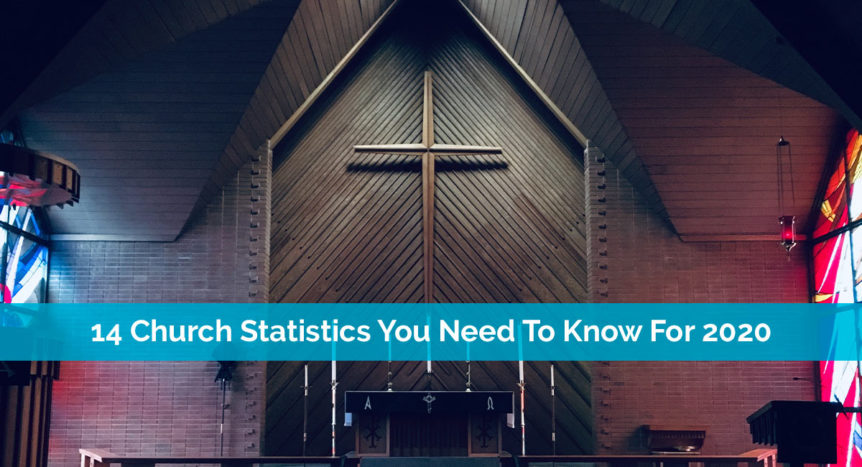UPDATE – We have published a newer version of this post with all new church statistics: 25 Church Statistics You Need To Know For 2021
Church trends and the needs of your members and the unchurched change every year. Sometimes, it’s hard to stay on top of these changes and adjust your church’s strategy to maintain growth.
Thankfully, church statistics give you more insight into the current state of the church, what Christians think and want, how to reach more people and how to keep your church growing.
Each year at REACHRIGHT, we put together a list of church-related stats that help give us a feel for the state of the church. If you are looking for previous years editions you can find them here:
- 37 Church Statistics You Need To Know for 2019
- 10 Church Statistics You Need To Know For 2018
- 9 Important Church Statistics For 2017
Even though some statistics might make it seem like no one’s attending, the truth is, there are still plenty of Christians who are seeking the comfort of a loving church family both in church and online.
Table of contents
- 1. Half Of Americans Belong To A Church
- 2. Growing Number Without A Religious Preference
- 3. Fewer Millennials Attend Church
- 4. Religious Preferences By Generation
- 5. Christianity Holds Surprisingly Steady
- 6. Rise In Outsourcing
- 7. YouTube Is Golden For Churches
- 8. Micro-Marketing Is The New Norm
- 9. Data Is Essential To Church Growth
- 10. Charitable Giving In A Nutshell
- 11. Donations Are Actually Growing
- 12. Your Members Are Online
- 13. Paid Social Is A Necessity
- 14. Share From Others For More Engagement

1. Half Of Americans Belong To A Church
According to a Gallup Poll study, 50% of Americans belong to a church. Even though that number has dropped 20% since 1999, you shouldn’t be concerned. It is a decline, but you have to consider that some people who attend church regularly don’t always attend the same church.
Individuals and families who move around often may choose not to become a member. They simply attend services at a church that’s close to them at the time.
Of course, Americans don’t observe Sunday as a day of rest quite like they used to. Many have no choice but to work during regular services. This doesn’t mean they don’t want to attend church. Instead, they seek out churches that offer videos of their sermons and an active online community.
The takeaway is Christians are changing. You may need to offer more than standard Sunday and Wednesday services to grow your church and increase tithing.
2. Growing Number Without A Religious Preference
One of the more odd church statistics comes from the same Gallup Poll. Currently, 19% of Americans don’t have a religious preference. This is up from the 2000 survey where only 8% stated that didn’t have a religious preference.
That doesn’t mean those Americans aren’t religious. Some actually still attend a church and may even be a member of a church. However, most of these Americans don’t attend church at all.
The reasons vary greatly, but it’s a good idea to poll people at community events your church hosts to better understand why they don’t have a preference and what would help them be more likely to attend church.
3. Fewer Millennials Attend Church
Odds are, this probably doesn’t come as a surprise to you. Most of the decline you see in church growth and attendance comes as a direct result of millennials reaching adulthood and starting families. Since fewer of this generation attend church, churches are noticing less regular attendance and members.
The Gallup Poll shows that only 42% of millennials attend church. This is the lowest generational percentage. Traditionalists come in at 68%, which is down from 77% in 2000. Even more generation X individuals attend church, though their rate has declined to 54% from 62%.
One way to reach more millennials is by engaging them more. While some do prefer a more traditional church, many want to be more involved and become active participants in helping others and the local community. Churches who want to reach this demographic may also need to invest in newer technology and online strategies.

4. Religious Preferences By Generation
It’s easy to see a trend in the decline of religious preference as each generation as grown into adulthood. Traditionalists, which are the oldest generation polled, came in with the highest religious preference of 89%. This means most traditionalists had a set religion. Of course, organized religion was far more prevalent with this generation.
These numbers start to drop slightly with the baby boomer generation. While 84% of them had a religious preference, it’s still a decline. Generation X drops slightly more to 79% with millennials dropping to just 68%.
The wider availability of denominations and non-denominational churches are likely part of the reason. Plus, younger generations don’t always engage the same way as their older counterparts. Offering something for all ages helps to prevent generational gaps in religion.
5. Christianity Holds Surprisingly Steady
Unless you’ve been hiding under a rock, you’ve likely seen plenty of church statistics that say Christianity is doomed. Some even talk about declines so sharp that there isn’t any way to recover.
You could opt for the doom and gloom approach, or consider the fact that church attendance has always ebbed and flowed. Millennials are among the highest number of unchurched individuals. However, they’re still the youngest adult generation.
As The New York Times points out, short study spans of a few years don’t accurately reflect attendance trends. It’s not unusual for generations to stop attending church as they leave home and first start families. However, a generation’s attendance often picks back up as they get older. This can mean that in another decade, more millennials may start to go back to church.
6. Rise In Outsourcing
Churches are finally starting to realize the value of outsourcing. This is giving them more time to focus on ministering to their members, the community and even their online church family. Engagement is crucial and a pastor who has more time to do this, create more ministry leaders and guide others in their faith is going to reach more people.
Some general outsourcing statistics to prove the rise in outsourcing include:
- 53 million Americans are freelancers
- The global outsourcing market is worth $85.6 billion as of 2018
- Over 93% of businesses use cloud technology as part of their outsourcing strategy
Many churches have invested in outsourcing in the form of virtual assistants. Not only can you save time, but money as well. Plus, it can help your church run more smoothly.

7. YouTube Is Golden For Churches
Church marketing is sometimes a touchy subject. However, the Internet has made it easier and more affordable than ever. Building an online following gives your church an extended church family online. Why is this good? First, you’re reaching more people. Second, those people often tithe just as much as people who attend your church in person.
YouTube is one of the best ways to reach people. While Facebook is still the king of social media, YouTube focuses solely on videos, which people love. Some church statistics that might interest you about YouTube include:
- YouTube has over two billion users
- Millennials are the biggest audience
- Over a billion hours of video is watched daily
- Over 70% of views come from mobile devices (another key trait of millennial viewers)
If you want to reach millennials, your church should consider YouTube. Creating videos that are 5-10 minutes long isn’t overly difficult. Special musical numbers, funny Christian skits and interviews with Christian leaders are just a few ideas to help your church be a part of those daily billion views.
8. Micro-Marketing Is The New Norm
Marketing to the masses just isn’t as effective as it used to be. People have far too many different media sources for it to work. Plus, churches often don’t have the budget to advertise everywhere.
To get the most for your church’s marketing budget, it’s time to invest in the micro-marketing trend. Instead of just choosing a general demographic or location, you get highly specific. For instance, you might only target 18-34 year-olds who live within 20 miles of your church’s city.
With online platforms collecting so much data about the users, it’s easy to target these smaller groups who may not even see your ads any other way. Targeted marketing has always been more effective. Micro-marketing is just a way of breaking your target audience down into smaller groups for better personalization.
Instapage gathered 68 personalization statistics that show that a more personalized approach works better. For example, personalized emails are six times more effective. When it comes to digital ads, 63% of millennials are more likely to engage with a personalized ad.
9. Data Is Essential To Church Growth
It’s hard to talk about church statistics without pointing out that churches who want to grow need to learn how to make the most of the data they collect. This includes data about members, online followers and even church statistics.
With 84% of churches either plateauing or declining, it’s vital to put your data to good use. We’ve created a guide to what types of data to collect and how to analyze it.
Businesses of all sizes use data to reach their target audience, improve products/services, predict trends and much more. Believe it or not, churches can do the same without spending much at all.

10. Charitable Giving In A Nutshell
Religious organizations still account for the most charitable donations among all nonprofits in America. This is great news for your church. This means Americans are still giving, but the ways they give are changing. Even though overall attendance has declined, many churches are discovering that online tithing from social media and website followers is helping to bridge that gap.
Some of the more eye-opening charitable giving statistics include:
- 80% of those who give have zero credit card debt. Odds are, this is likely your older demographic as many millennials have credit card debt, student loans and mortgages.
- 60% of people prefer to give digitally or online.
- Churches can increase tithes by 32% by offering an online option.
- 37% of members who attend church regularly don’t tithe.
- 77% of people who do tithe give over 10% of their income, with some giving as much as 20%.
- Only 1% of members who earn over $75,000 a year give at least 10% of their income.
11. Donations Are Actually Growing
One of the more promising church statistics is that donations are actually on the rise. Despite lower attendance and fewer millennials, people are giving more to churches.
Donations to churches and other types of religious organizations rose by 3.3% in 2019 to $131.5 billion. The average annual growth rate is 1%. Even though that might not seem like much, a 1% increase raises the annual donation amount by over $13 million.
Even more important is that the $131.5 billion is divided among just 189,571 houses of worship.
12. Your Members Are Online
Despite the popularity of the Internet, many churches still refuse to get online. However, your members are online. Potential members are online. People who can’t attend church, but want to, are online. You can see the pattern here.
Currently, 57% of the world uses the Internet and 45% of the population uses social media. There are 3.4 billion people using social media regularly. That’s too large of a number to ignore. In just a single year, social media users increased by over 288 million. In fact, 83% of North America uses social media.
Social media users spend 50% of their online time using social media and streaming video. Of course, it shouldn’t surprise you that younger users prefer online content. This means if your church isn’t online, they probably aren’t going to engage with you at all.
It’s better to spend your marketing time on a strategy that will reach the most people. It’s not just young people using the Internet and social media. People from all generations use it.
13. Paid Social Is A Necessity
This is probably one of those church statistics you’d rather not be true. However, social media has so many users that businesses and nonprofits are desperate to reach them. While the right thing would be for social media to let the users choose what they want to see and from whom, the opposite is actually true.
Even if your church’s social media followers want to see every post, they won’t. Social media algorithms have changed from a simple chronological order to what they think is most important to users. In a nutshell, very few business and nonprofit posts reach users’ timelines and news feeds.
Some pages only have an organic reach of 2%. When you’re trying to reach more people, 2% just isn’t enough. Investing in low-cost ads and sponsored posts helps you reach people faster. It’s not just Facebook, either. Instagram is doing the exact same thing.
Once they’re interested, ask them to engage with your posts frequently so they show up organically more often. The more a user engages with a specific user, page or group, the more often posts show up for them.
14. Share From Others For More Engagement
As one last insight about growing your church through social media, 51% of users are more likely to engage with a brand that shares real users’ content. For instance, if a member shares a picture of them doing something at church, they’re going to interact with your page more if you share that picture with your followers. User-generated content is an easy way to engage your users and have more relevant posts too.
2020 could be a major year for your church. Use these church statistics to develop a new strategy. If you’re not online already, start by seeing how our website services help your church succeed online.
[print-me]





Comments 11
Two comments
1. many major denominations ignore the Holy Spirit and the power he has to bring believers in their relationship with Jesus. In fact, some are so hostile they refuse to allow teaching that would expose their membership to the role of Holy Spirit and his role in the life of a believer. the Holy Spirt comes the fruits of the Holy Spirit. These fruits bring believers alive in their faith.
2. Number of attendees is not critical statistic for the growth of a church while important statistic is the percentage of attendees who are true believers and who they are. This knowledge is critical to the message and focus on services offered.
I taught change management to pastors and other leadership a while back. At that time the percentage was 25%. I would like to see more current statistics.
Author
Thanks for your thoughts Elizabeth!
Totally agree – the Holy Spirit’s role is essential in believers’ lives and can truly energize a church community.
You’re right, it’s not just about attendance numbers. Spiritual growth and genuine connections matter too.
Appreciate your input and experience.
Any statistics on the disabled community and their percentage of attendance? This seems to be a lost demographic in most churches.
Author
I haven’t seen any but would love to add them to this post if anybody has some stats on this.
Jodee, the short answer is no, but we only have to look at church buildings to realize that our differently-abled sisters and brothers face incredible barriers to attending worship.
I am on the Accessibilities Committee for the United Methodist Church in the Illinois Great Rivers Conference. Since this is church speak, it means all of the United Methodist churches south of I-80, think Moline and south. We are making churches more aware of the needs of our differently-abled sisters and brothers so that they may worship with us.
The barriers that they face are mostly unknown to people who have never had to use a cane, crutches or a walker. Able bodied folks don’t have to worry about doors that open outwards, bathrooms not located on the main floor or gravel parking lots.
If you like I can send you a copy of our Church Accessibility Audit, just email me at the address below.
Author
Thanks for adding to the discussion Jim, and thank you for what you do to help make it easier for everyone to worship!
I am hoping to find a ten year trend on average attendance per month. If you can point me in the right direction I would be extremely appreciative.
Author
I haven’t seen that data. Maybe one of our readers can help us with that.
We are interested in having online church. Pls advice
Author
We would love to chat. The easiest way to connect with our team is here – https://reachrightstudios.com/new-church-website-quote-6/
The only reason, the real reason why pastors and churches fail is lack of compassion from the Shepherd to lead each member of the flock to Jesus as Saviour and then teach the flock to study the Word, teach the flock to read and understand the Word and OBEY GOD; then live for God, listen to Him, love HIM and OBEY.
Amen in Jesus Name!